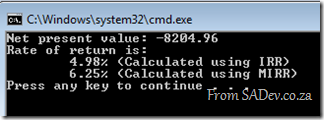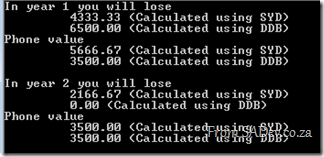 [This blog is part of a larger series, to find more parts in the series please see the Series Index]
[This blog is part of a larger series, to find more parts in the series please see the Series Index]
Yesterday’s post covered some interesting, yet very simple features in Microsoft.VisualBasic so today I thought I would cover some more complex code: Financial.
This is a class with 13 static method who all return a Double, and if financial code wasn’t complex to begin with the method names are as cryptic as you can get. I’ve broken them into three groups: cash flow, general, depreciation and annuity based.
Cash Flow
These calculations look at investments and cash flows:
- IRR: Provides the internal rate of return for a series of periodic cash flows.
- MIRR: Provides the modified internal rate of return for a series of periodic cash flows.
- NPV: Provides the net present value of an investment.
Example of using the above methods:
// need to place to store profit/loss
// must have atleast one negative and one postive value in it
IList<double> values = new List<double>();
values.Add(-100000); // startup costs - cost money to make money
values.Add(10000); // income in first year
values.Add(15000); // income in second year
values.Add(17500); // income in third year
values.Add(75000); // income in forth year - got govt. contract that year ;)
double[] valuesArray = values.ToArray();
double loanRateGuess = 0.1; // start guessing loan at 10%
double rateIRR = Financial.IRR(ref valuesArray, loanRateGuess) * 100;
double reinvestmentRate = 0.12; // MIRR also includes the reinvestment rate 12%
double rateMIRR = Financial.MIRR(ref valuesArray, loanRateGuess, reinvestmentRate) * 100;
// working out net present value needs a fixed rate
double fixedRate = 0.08; // 8%
double netPresentValue = Financial.NPV(fixedRate, ref valuesArray);
Console.WriteLine("Net present value: {0:0.00}", netPresentValue);
Console.WriteLine("Rate of return is:");
Console.WriteLine("\t{0:0.00}% (Calculated using IRR)", rateIRR);
Console.WriteLine("\t{0:0.00}% (Calculated using MIRR)", rateMIRR);
Gives us:
Depreciation
I understand depreciation as: how much value an item loses over time.
- DDB: Allows you to work out depreciation using the double-declining balance method (DDB) or a custom method. The DDB calculation per period is: Depreciation / Period = ((Cost – Salvage) * Factor) / Life
- SLN: Provides a value specifying the straight-line depreciation of an asset for a single period. SLN is calculated using:(Cost - Salvage) / Life
- SYD: Provides a value specifying the sum-of-years digits depreciation of an asset for a specified period. This is similar to DDB but calculated differently.
Example of using all the above methods to figure out how much you lose on an iPhone over two years:
double iPhoneInitialCost = 10000;
double iPhoneResale = 3500;
double YearsUntilNextUpdate = 2;
// work out deprecation per year
double deprectionPerYear = Financial.SLN(iPhoneInitialCost, iPhoneResale, YearsUntilNextUpdate);
double sydValue = iPhoneInitialCost;
double ddbValue = iPhoneInitialCost;
for (int year = 1; year < YearsUntilNextUpdate + 1; year++)
{
double syd = Financial.SYD(iPhoneInitialCost, iPhoneResale, YearsUntilNextUpdate, year);
double ddb = Financial.DDB(iPhoneInitialCost, iPhoneResale, YearsUntilNextUpdate, year);
sydValue -= syd;
ddbValue -= ddb;
Console.WriteLine("In year {0} you will lose", year);
Console.WriteLine("\t {0:0.00} (Calculated using SYD)", syd);
Console.WriteLine("\t {0:0.00} (Calculated using DDB)", ddb);
Console.WriteLine("Phone value");
Console.WriteLine("\t {0:0.00} (Calculated using SYD)", sydValue);
Console.WriteLine("\t {0:0.00} (Calculated using DDB)", ddbValue);
Console.WriteLine();
}
Which gives us the painful realisation of how quick value is lost:
Annuity Based
An annuity is a series of fixed cash payments made over time. An annuity can be a loan (such as a home mortgage) or an investment (such as a monthly savings plan).
If you are working out annuities there is a number of calculations around those:
- If you have the payment, period and interest you can work out the future value using FV over a period.
- If you have the future value, payment and period you can work out the interest using IPmt over a period.
- If you have the future value, payment, and interest you can work out the period using NPer over a period.
- If you have the future value, period and interest you can work out the payment using Pmtt over a period.
Other methods around annuities:
- PPmt: Calculate the principal payment of an annuity.
- PV: Calculate the present value of an annuity.
- Rate: the interest rate per period for an annuity calculated by iteration.
Example of using FV to work out savings:
double monthlySavings = 1000;
double interestRate = 8;
double yearsYouWillSave = 10;
double deposit = 0;
// specifies if you save at start or end of month
DueDate dueDate = DueDate.EndOfPeriod;
if (interestRate > 1)
{
// must be expressed as a percentage
interestRate = interestRate / 100;
}
// converted to interested per month
interestRate = interestRate / 12;
// figure out how many months that is
double months = yearsYouWillSave * 12;
// note savings and deposit are converted to negative as we are saving
// if we were paying off they would be positives
double savings = Financial.FV(interestRate, months, -monthlySavings, -deposit, dueDate);
Console.WriteLine("In {0} years, you will have saved: {1:0.00}", yearsYouWillSave, savings);
gives us:


